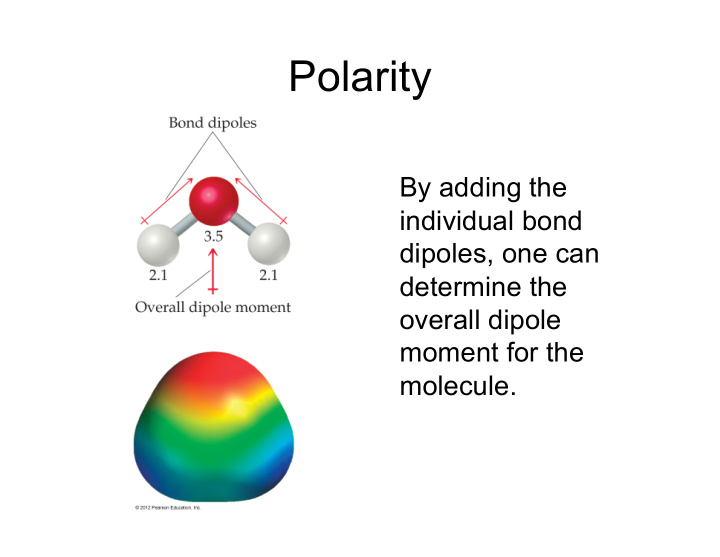



Polarity By adding the individual bond dipoles, one can determine the overall dipole moment for the molecule.
Polarity
Polarity
Electron Domains • We can refer to the electron pairs as electron domains . • In a double or triple bond, all electrons shared between those two atoms are on the same side of the central atom; • The central atom in therefore, they count as this molecule, A, one electron domain. has four electron domains.
Valence-Shell Electron-Pair Repulsion Theory (VSEPR) � The best arrangement of a given number of electron domains is the one that minimizes the repulsions among them. �
Molecular Geometries
Molecular Geometries Within each electron domain, then, there might be more than one molecular geometry.
Linear Electron Domain • In the linear domain, there is only one molecular geometry: linear. • NOTE: If there are only two atoms in the molecule, the molecule will be linear no matter what the electron domain is.
Trigonal Planar Electron Domain • There are two molecular geometries: – Trigonal planar, if all the electron domains are bonding, – Bent, if one of the domains is a nonbonding pair.
Tetrahedral Electron Domain • There are three molecular geometries: – Tetrahedral, if all are bonding pairs, – Trigonal pyramidal, if one is a nonbonding pair, – Bent, if there are two nonbonding pairs.
Trigonal Bipyramidal Electron Domain • There are four distinct molecular geometries in this domain: – Trigonal bipyramidal – Seesaw – T-shaped – Linear
Trigonal Bipyramidal Electron Domain Lower-energy conformations result from having nonbonding electron pairs in equatorial, rather than axial, positions in this geometry.
Octahedral Electron Domain • All positions are equivalent in the octahedral domain. • There are three molecular geometries: – Octahedral – Square pyramidal – Square planar
Nonbonding Pairs and Bond Angle • Nonbonding pairs are physically larger than bonding pairs. • Therefore, their repulsions are greater; this tends to decrease bond angles in a molecule.
Multiple Bonds and Bond Angles • Double and triple bonds place greater electron density on one side of the central atom than do single bonds. • Therefore, they also affect bond angles.
Larger Molecules In larger molecules, it makes more sense to talk about the geometry about a particular atom rather than the geometry of the molecule as a whole.
Overlap and Bonding • We think of covalent bonds forming through the sharing of electrons by adjacent atoms. • In such an approach this can only occur when orbitals on the two atoms overlap.
Overlap and Bonding • Increased overlap brings the electrons and nuclei closer together while simultaneously decreasing electron– electron repulsion. • However, if atoms get too close, the internuclear repulsion greatly raises the energy.
Hybrid Orbitals • These two degenerate orbitals would align themselves 180 ° from each other. • This is consistent with the observed geometry of beryllium compounds: linear.
Hybrid Orbitals With carbon, we get four degenerate sp 3 orbitals.
Electron-Domain Geometries Table 9.1 contains the electron-domain geometries for two through six electron domains around a central atom.
Bonds
Multiple Bonds • In a molecule like formaldehyde (shown at left), an sp 2 orbital on carbon overlaps in s fashion with the corresponding orbital on the oxygen. • The unhybridized p orbitals overlap in p fashion.
Multiple Bonds In triple bonds, as in acetylene, two sp orbitals form a s bond between the carbons, and two pairs of p orbitals overlap in p fashion to form the two p bonds.
Delocalized Electrons: Resonance
Delocalized Electrons: Resonance
Resonance The organic molecule benzene has six s bonds and a p orbital on each carbon atom.
Resonance • In reality the p electrons in benzene are not localized, but delocalized. • The even distribution of the p electrons in benzene makes the molecule unusually stable.
Molecular-Orbital (MO) Theory
MO Theory
MO Theory • For atoms with both s and p orbitals, there are two types of interactions: – The s and the p orbitals that face each other overlap in s fashion. – The other two sets of p orbitals overlap in p fashion.
MO Theory
MO Theory • The smaller p -block elements in the second period have a sizable interaction between the s and p orbitals. • This flips the order of the s and p molecular orbitals in these elements.
Second-Row MO Diagrams
Recommend
More recommend